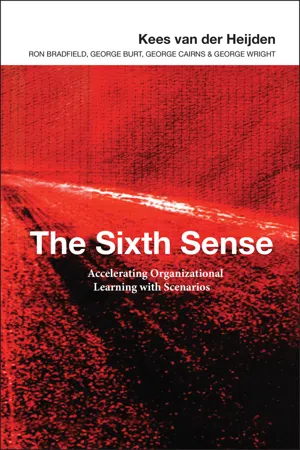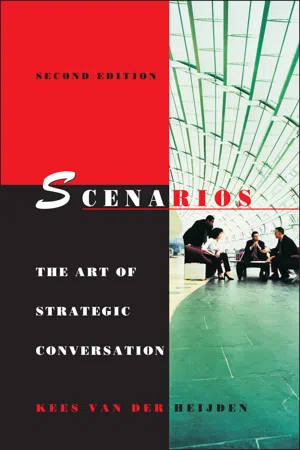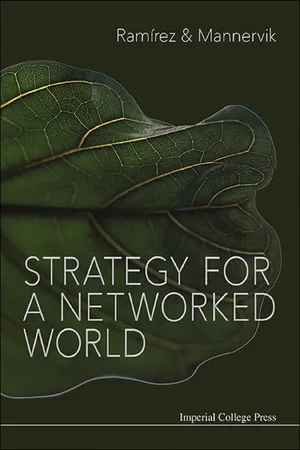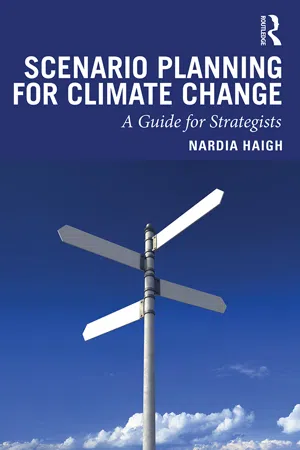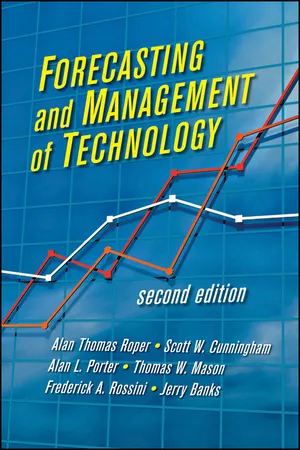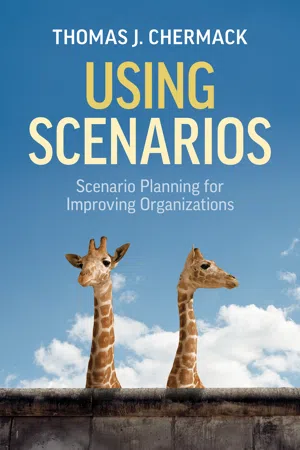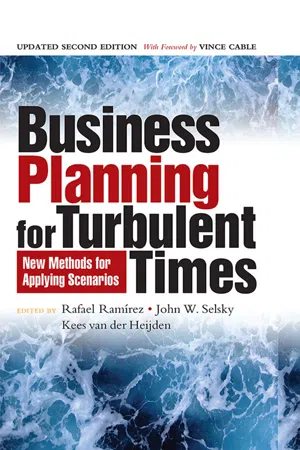Business
Scenario Analysis
Scenario analysis is a strategic planning technique that involves creating and analyzing different possible future scenarios to anticipate potential outcomes and make informed decisions. It helps businesses prepare for various situations by considering multiple factors such as market trends, economic conditions, and industry changes. By exploring different scenarios, organizations can develop robust strategies to adapt to changing environments.
Written by Perlego with AI-assistance
Related key terms
Related key terms
1 of 4
Related key terms
1 of 3
10 Key excerpts on "Scenario Analysis"
- eBook - ePub
Managing Information Services
A Sustainable Approach
- Jo Bryson(Author)
- 2017(Publication Date)
- Routledge(Publisher)
Scenario planning enables organizations to determine what is of strategic importance and concern to the organization and to explain this in terms of the impact they have on the organization. Participants in the process are required to look at concerns and uncertainties, future directions, pivotal events, decisions both for the short and long terms, constraints and what people would like to be remembered for, and develop a series of possible scenarios or stories of the future. The scenarios are constructed in a workshop environment and are each given a name that can be instantly recognized, based on the storyline or data in the scenario.Capturing multiple images of the future that together encompass the critical uncertainties facing the organization is one of the two key goals of scenario developers. The other goal is to convince managers at all levels of the organization to consider seriously the strategic and tactical implications of each scenario (Ringland 2003 : 22).The scenarios are not used to predict the future, but highlight options based on what is known and unknown. The advantage is that scenario planning assists organizations to think outside of the box by challenging and stretching conventional thinking in order to map out the future. It is concerned with anticipating the potential future and preparing action plans today that will safeguard organizations tomorrow (Walton 2009 : 339 quoting Weiss 2003). Scenario planning can be used in developing the organization's strategic plan, particularly:- In a business environment of high uncertainty;
- For generating new opportunities;
- For developing a common language throughout the organization; and
- Where there are strong differences of opinion.
- eBook - ePub
The Sixth Sense
Accelerating Organizational Learning with Scenarios
- Kees van der Heijden, Ron Bradfield, George Burt, George Cairns, George Wright(Authors)
- 2009(Publication Date)
- Wiley(Publisher)
CHAPTER 7Scenario Planning in the Organizational ContextPrevious chapters have explored the blockages to organizational thinking and outlined the philosophy underpinning the scenario approach. This chapter provides a step-by-step guide to the scenario approach, enabling managers to challenge their own cultural perceptions of specific business situations.OverviewThe business world is ambiguous, subtle and complex; recognizing the unpredictability of such a situation is the key strength of an effective scenario process. No other strategic approach is capable of linking cause and effect to seemingly unrelated factors, where the nature of possible futures can dramatically affect organizational success. Scenarios provide unique insights, harnessing knowledge, skills and distinctive competencies to drive organizations forward.In this chapter, we will outline the structure, context and implications of the scenario planning process by exploring five key areas:• Structuring the scenario process. Adopting the correct approach involves identifying gaps in knowledge, building the team and timing the project.• Exploring the scenario context. Interviewing key players will surface relevant information about the team’s current thinking and approach. Analysing the interviews, feedback and discussion helps to define the scope of the project and set the agenda. The role of the ‘remarkable person’ is to challenge the team’s thinking, preconceptions and preprogramming• Building the scenarios. It is critical to identify the driving forces in the environment. Through testing outcomes, the impact and uncertainty of options can be illuminated. Scoping the scenarios and fully developing coherent stories will highlight the implications for the organization.• Stakeholder analysis - eBook - ePub
Scenarios
The Art of Strategic Conversation
- Kees van der Heijden(Author)
- 2011(Publication Date)
- Wiley(Publisher)
The learning loop is not closed until we have addressed the link between new insights and actions. Actions result from decisions taken by people with the power to act. Decisions-to-act are taken under the influence of an avalanche of experiences, interpreted as the consequences of earlier actions. The output of the Scenario Analysis as such does not cause action, but it influences the learning loop that mediates between experience and action. The scenario work will have effect in various places in the corporate learning loop. For example, it will help the organisation to filter in experiences that would otherwise not have made it to institutional consciousness. It provides additional systemic structure to question long-standing recipes and enhance theories-in-use. It builds coherence and optimism that enables decision making.In this chapter we will consider the way in which the Scenario Analysis affects the theories-in-use in the organisation. The scenario planner needs to consider the impact made and think about how this can be optimised. How does decision making take place in the context of a scenario-based planning approach? This is the area of adaptive scenario-based planning.DEVELOPING STRATEGIC DIRECTION
Scenarios can provide the basics of strategy through addressing questions in two categories:- The internal perspective; is our organisation equipped to survive and flourish in any of the multiple equally plausible future environments we may be facing (organisational capability)?
- The external perspective; are we developing our business(es) in the right territory, considering the sort of organisation we are and the environment we may encounter (business portfolio)?
- Capability review.
- Portfolio review.
- Strategic option generation.
- Strategic option testing.
The dialogue in all these steps is essentially about the ability of the organisation to survive and grow. The issue raised at this point addresses the question whether this organisation is well prepared to face the uncertainties of the future as portrayed in the completed set of scenarios. Remember that the scenarios are not forecasts, none of them will actually happen. But as a set they are a representation of ‘‘the sort of thing that could happen’’ in the outside world. They need to be considered against an equivalent representation of the organisation itself, out of which strategic conclusions emerge. The strategic dialogue requires a language, in which the essence of organisational capability and success can be expressed. As we have seen, the concept of the Business Idea serves this purpose. The Business Idea expresses the basis of the organisation’s overall competitive strength and growth principle. - eBook - ePub
- Rafael Ramírez, Ulf Mannervik;;;(Authors)
- 2016(Publication Date)
- ICP(Publisher)
Scenario planning has been used in companies since the 1960s (Lesourne & Stoffaes, 2001; Grant, 2003; van der Heijden, 2005) and even longer by military planners and policy-makers. It serves a wide variety of purposes, which may include efforts to reframe the understanding of a situation, to help to reperceive strategic opportunities, to improve the quality of strategic conversations, to correct judgement biases, to enhance organisational learning, to influence stakeholders, to help different parties identify and agree upon common ground, to create new relationships, to reach out to new co-creators, to surface and question assumptions in models or strategy; to make sense of ambiguous settings; to have a common language to join up disjointed organisational divisions; or to research and clarify complex issues.As Figure 7.1 illustrates, in scenario planning we distinguish between the more immediate business (or “transactional”) environment that a strategist (CEO or team in a firm) influences through their interactions with counterparts (who, from their point of view, are “actors” or “interactors”) from the “factors” around these interactors, which remain beyond the strategist’s influence — and which constitute and are situated in the broader “contextual” environment.Figure 7.1: The Transactional and the Contextual Environments2Scenarios are constructed by analysing the factors and how these might relate to each other in the future; and once a plausible contrasting set of such scenarios are constructed, then the inquiry moves into what transactional or business environment might arise in each of those scenarios.While there are very many “methods” to develop a set of scenarios in scenario planning, with different authors proposing different numbers of steps (for an overview see Ramírez & Wilkinson, 2016), all involve the aspects, which were summarised by Wilkinson, Selin and Ramírez in the Oxford Scenarios Programme (see Figure 7.2 ).Research has established that scenario planning is an approach well suited to support strategy in conditions where forecasting is either unreliable or less applicable. These conditions are turbulent environments (van der Heijden, 1996; Ramírez et al - eBook - ePub
Scenario Planning for Climate Change
A Guide for Strategists
- Nardia Haigh(Author)
- 2019(Publication Date)
- Routledge(Publisher)
By considering multiple future scenarios far in advance of their potential emergence, and by identifying warning signals, scenario planning gives organizations more time to anticipate potential upcoming changes, and to develop a variety of cost-effective options to be implemented if and when needed. In this sense, scenario planning develops a keen sense of strategic timing that will enable you to stay ahead of emerging change, stay ahead of competitors, and decide when and how to respond. If you can relate to this statement by Harvard Business School – “if you wait for a trend to be validated … the window of opportunity will have closed or the threat will have already torpedoed your company” 1 – then scenario planning can help you to identify trends well ahead of their emergence, and enable you to get ahead of upcoming threats and opportunities by timing your response. In conclusion, a stand-alone five-year strategic planning process focused on a single view of the future is ineffective, and complementing it with scenario planning will help to overcome its limitations, while building valuable in-house capabilities to strategize rigorously and flexibly for the long term. References 1 Harvard Business School. 2000. Scenario planning reconsidered, Harvard Management Update, 5/9: 4. 2 Wilkinson, A. and R. Kupers. 2013. Living in the futures, Harvard Business Review, 91/5: 118–127. 3 Schwab, S.J. and R.S. Thomas. 2006. An empirical analysis of CEO employment contracts: What do top executives bargain for, Washington and Lee Law Review, 63: 231–270. 4 Wack, P. 1985. Scenarios: Shooting the rapids, Harvard Business Review, 63/6: 139–150. 5 Wade, W. 2012. Scenario Planning: A Field Guide to the Future. Hoboken, USA: John Wiley & Sons. 6 Schoemaker, P.J.H. 1995. Scenario planning: A tool for strategic thinking, Sloan Management Review, 36/2: 25–40. 7 Wack, P. 1985. Scenarios: Uncharted waters ahead, Harvard Business Review, 63/5: 73–89. 8 Sharot, T., A.M. Riccardi, C.M - The Open Group(Author)
- 2022(Publication Date)
- Van Haren Publishing(Publisher)
— More detailed descriptions of human to computer interaction— Typically used in software development projects• Business models nor business cases nor Business Scenario plans (as in Forbes …):— However a Business Scenario can be informed by a company’s business model— A SMART Business Scenario can inform a business case and/or a business model and/or Business Scenario plan• SPIN (as in Situation, Problem, Implication, Need Payoff selling strategy):— SPIN is a sales technique that can be used to gather information for a Business Scenario— A Business Scenario can provide the seller some relevant “context” for a SPIN engagement• A substitute for any typical engineering specifications (as from IEEE):— Which are much more detailed, material-specific, and tied more to sciencePassage contains an image
38 Benefits of Business Scenarios
A Business Scenario is essentially a complete description of a business problem, both in business and in architectural terms, which enables individual requirements to be viewed in relation to one another in the context of the overall problem. Without such a complete description to serve as context:• There is a danger of the architecture being based on an incomplete set of requirements that do not add up to a whole problem description, and that can therefore misguide architecture work• The business value of solving the problem is unclear• The relevance of potential solutions is unclearAlso, because the technique requires the involvement of business line management and other stakeholders at an early stage in the architecture project, it also plays an important role in gaining the buy-in of these key personnel to the overall project and its end-product – the Enterprise Architecture.An additional advantage of Business Scenarios is in communication with vendors. Most architecture today is implemented by making maximum use of Commercial Off-The-Shelf (COTS) software solutions, often from multiple vendors, procured in the open market. The use of Business Scenarios by a customer can be an important aid to vendors in delivering appropriate solutions. Vendors need to ensure that their solution components add value to an open solution and are marketable. Business Scenarios provide a language with which the vendor community can link customer problems and solutions. Besides making obvious what is needed, and why, they allow vendors to solve problems optimally, using open standards and leveraging each other’s skills.- eBook - ePub
- Alan L. Porter, Scott W. Cunningham, Jerry Banks, A. Thomas Roper, Thomas W. Mason, Frederick A. Rossini(Authors)
- 2011(Publication Date)
- Wiley(Publisher)
The Oxford English Dictionary provides three definitions of uncertainty. The second is the one with which the remainder of the chapter will be concerned (OED Online 2011): A sketch, outline, or description of an imagined situation or sequence of events; esp… . (b) an outline of an intended course of actionScenarios are a natural outgrowth of efforts to help organizations adapt to their rapidly changing environments. In assisting organizations in making decisions, forecasters face several problems. Qualitative techniques, such as checklists, often fail in the important tasks of engaging decision makers and facilitating organizational learning. On the other hand, solely quantitative approaches often are not appropriate. Moreover, narrow assumptions about the future can result in overly rigid prescriptions for future actions. Recognition of these issues has led to development of several distinct scenario methodologies.Strength, Weakness, Opportunities, Threats (SWOT) analyses were some of the precursors to modern Scenario Analysis approaches (Spies 1994). Newer approaches include the Shell scenario approach (Wack 1985a, 1985b; Schwartz 1991; Van der Heijden 2005), as well as the RAND planning approach (Dewar 2002; Lempert, Popper, et al. 2003). In the following sections, a methodology that integrates both of these perspectives is presented.7.2.1 Steps in Creating Scenarios
The narratives, in many ways, are the most characteristic feature of Scenario Analysis. However, a lot of preliminary work must precede them. There are five steps in constructing a scenario:- Identifying variables
- Developing levels of measurement
- Characterizing significant variables
- Creating scenarios
- Writing the narrative
Step 1 entails identifying meaningful external variables for the technological system in question. The technology delivery system constructed for the forecast will help, but the forecaster should think broadly and comprehensively, as if participating in a brainstorming exercise (see Section 4.3.7). For instance, he or she might search through the space of possible social, political, economic, institutional, legal, environmental, or technological variables that might affect the system. The variables that are identified are called scenario variables - eBook - ePub
Using Scenarios
Scenario Planning for Improving Organizations
- Thomas J. Chermack(Author)
- 2022(Publication Date)
- Berrett-Koehler Publishers(Publisher)
Strategy and scenarios are necessarily linked. Ideally, scenarios open up thinking, and strategy gets to action decisions. Each realm of practice is missing something: scenarios lack a connection to action, and strategy lacks up-front analysis of multiple futures. Though some have tried, simply pushing the two processes together misses the mark. Taking a closer look at how these two processes can be more effectively connected is critical for getting to better organizational futures. This book provides a stepping-stone between scenario planning and strategic planning—it is an effort intended to address the gap between them.One challenge put forth in this book is that scenarios are critical to strategy, and the connection between the two is essential for advancement. The way to accomplish this connection is to describe how scenarios can be used, which is the purpose of this book. When thinking about how to advance the practice of scenario and strategic planning, keep these definitions in mind:• Scenarios are descriptions of multiple, different futures.• Scenario planning is the process of developing scenarios and using them for strategic action.• Strategy is how an organization intends to reach its goals and objectives.• Strategic planning is the process of developing goals and objectives and describing how to achieve them.Strategy and scenarios can have great utility, though there are problems with the practice of both. Understanding the common reasons why strategic and scenario planning often fail is the first step toward improved practice. Because these processes address how organizations fit in their environments, improving how these processes are practiced is an important and serious objective.Strategic planning has a long history of mixed results (Iyanda Ismail et al., 2020; Kanu, 2020; Nilsson et al., 2020; Rudd et al., 2008). It is often something done on an annual basis because it has always been done. Why do companies conduct strategic planning each year? Maybe because it is comfortable, people know what to expect, and it can often be concluded in about two days? In most cases it’s like the required reading for the year ahead. It is simply going through the motions—easy and predictable. The ritual carries on, even though most people are aware that it does not produce the desired living strategy. Finally, the majority of strategic plans contain such general and vaguely defined strategies that you couldn’t possibly do a single thing with them! - eBook - ePub
Scenario Planning in Organizations
How to Create, Use, and Assess Scenarios
- Thomas J. Chermack(Author)
- 2011(Publication Date)
- Berrett-Koehler Publishers(Publisher)
Scenarios are like cherry trees: cherries grow neither on the trunk, nor on the large boughs; they grow on the small branches of the tree. Nonetheless, a tree needs a trunk and large branches in order to grow small branches. The global, macro-scenarios are the trunk; the large branches are the country scenarios developed by Shell operating companies, in which factors individual to their own countries—predetermined and uncertain—are taken into account and added. But the real fruits of the scenarios are picked at the small branches, the focused scenarios which are custom tailored around a strategic issue or a specific market or investment project. (p. 83)To apply scenarios in this tiered way, decision makers would have to entertain several rounds of scenario construction. This is why most single instances of scenario planning fail. For example, first the global/macro scenarios should be constructed. These simply set the context for the appropriate industry. These are likely to be scenarios that capture external factors only. Once complete, and depending on the size of the organization, decision makers can move into more specific scenarios focused on a region (in the case of a truly global organization with numerous regional offices) or a specific strategic issue. When scenario planning is adopted as a way of thinking in organizations, the ways in which scenarios can be used expands drastically.FIGURE 5.2 Scenarios Are Like Cherry TreesTo do specific analyses of parts of the business, one develops “focused scenarios” custom-tailored around a strategic issue, or a specific market or investment project. But you cannot start with such focused scenarios because you will almost certainly miss key things, or cast the focused scenarios in the wrong way. You must wide-angle first, to get the big picture, and them zoom in on your business specifics. (Wack, 1985a, p. 92)Some scenario planning experts favor a highly specific approach from the start. For example, Louis van der Merwe tells stories about scenario projects he has observed in which the facilitator spent two full days defining the initial strategic question. Asking the right question is important; and the more specific the purpose, the easier it is to assess upon project completion. However, the context, situation, decision maker conversations, and other information will determine the level of focus required. There are no hard rules here, but the context will usually indicate when enough detail is reached. Gaining people’s understanding and readiness to move forward is both hard to miss and a key indicator to proceed. - eBook - ePub
Business Planning for Turbulent Times
New Methods for Applying Scenarios
- Rafael Ramirez, John W. Selsky, Kees van der Heijden, Rafael Ramirez, John W. Selsky, Kees van der Heijden(Authors)
- 2010(Publication Date)
- Routledge(Publisher)
Enabling multiple perspectives on the future to be generated and evaluated simultaneously is crucial for managers in turbulent environments because it enables a richer set of response repertoires to be developed. In addition, the scenario-planning method structures the uncertainty that managers face from a contextual environment. It provides a sense of order, priority and significance that opens up choices, which differs from traditional strategic planning that is designed to eliminate choices. Scenario planning offers a structured way of capturing future contextual disruptions in whole systems in environments, instilling images previously not conceived of in the minds of participants (Schoemaker, 1993; Watkins and Bazerman, 2003; see also Chapter 12 in this volume). Ramírez and van der Heijden (2007, p97) suggest that strategic planning and scenario planning are best used in tandem. The transactional environment has been taken to be the usual arena for strategizing, and the contextual environment the usual arena for scenario planning. In this ‘wind tunnelling’ model, scenarios serve the function of questioning the boundary between the transactional and contextual environments, and delivering imaginative information to strategic planning. However, Ramírez and van der Heijden (2007) also suggest that strategic planning has been tethered to assumptions of a disturbed–reactive environment. They suggest that by using scenario planning in a new way, it might pull strategic planning into being more useful in a turbulent environment. They suggest an intervention called ‘staging inter-organizational futures’ can help managers to identify parts of the contextual environment that are misconstrued as non-controllable, and add these into transactional space amenable to strategic planning
Index pages curate the most relevant extracts from our library of academic textbooks. They’ve been created using an in-house natural language model (NLM), each adding context and meaning to key research topics.
Explore more topic indexes
Explore more topic indexes
1 of 6
Explore more topic indexes
1 of 4

